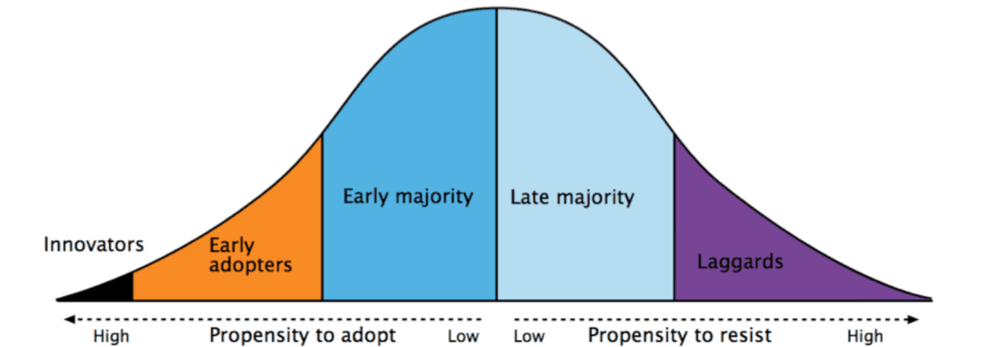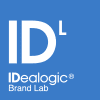According to Harvard Business School professor Clayton Christensen, there are over 30,000 new products introduced every year, and 95% fail. University of Toronto Professor Inez Blackburn has found that the failure rate of new grocery store products is 70 to 80%.
Product adoption success depends on many factors, including innovativeness, awareness, application, pricing, and consumer satisfaction. As indicated in our series introduction, this 2-part blog series focuses on the original adoption theory and its adaptions over time. In this first article, we dive into the origins of the Diffusion of Innovation theory and how it laid the groundwork for continuous evolution over time.
The Diffusion of Innovation Theory
In 1962, American sociologist Everett M. Rogers invented the Diffusion of Innovation theory to illustrate how innovations diffuse, or are adopted, through social systems. The theory suggests that the innovativeness of a product, behavior, or idea determines its adoption success. Rogers uses a bell curve to split consumers into five segment groups to showcase their willingness to purchase a product. The curve is divided into five adopter segments: Innovators, Early Adopters, Early Majority, Late Majority, and Laggards.

Innovators: 2.5% of consumers
The first to adopt a new innovation, this segment is venturesome and likes to try new ideas. Their desire to take risks sets them apart from the other adopter groups. To be an innovator, consumers must have access to substantial finances to make up for potential losses due to failed innovations. It is not difficult for a brand to capture this group when the product or service offered is aligned with their interests. Examples of innovators include those who wait in long lines to get the newest iPhone or Jordan sneaker.
“The innovator plays a gatekeeping role in the flow of new ideas into a social system.” – Everett M. Rogers
Early Adopters: 5% of consumers
More immersed in the social system than the innovators, this segment is an opinionated set that enjoys leadership roles, typically seen as role models or trendsetters. They are very comfortable with accepting change and adopting new ideas. People in this category tend to have higher social status and concentrated influence. Other adopter groups want the advice of this group to see if a new product or service is worth purchasing. This group plays the overall role of testing new innovations to decrease uncertainty and provide an evaluation to peers.
Early Majority: 34% of consumers
Influenced by the Innovators and Early Adopters, this highly social group is more likely to change behavior if it enhances lifestyle and productivity. These individuals aren’t leaders, however, they adopt new ideas more than the average buyer. This segment is more likely to rely on product reviews before purchasing. The Early Majority serves as the link between the adopter groups and provides interconnectedness in the system’s networks. Brands can appeal to this segment by highlighting product success stories and showcasing buyer reviews and testimonials.
Late Majority: 34% of consumers
This is a skeptical group that waits to purchase an innovation towards the end of its lifecycle. This segment buys new products or services once the earlier groups approve and recommend them. They can be pushed to purchase if they are pressured by society or economics. Because this group has relatively scarce resources, the innovation must be proven to be completely safe before adopting. Highlighting proven success stories and reviews is a strategic way to appeal to this consumer group.
Laggards: 16% of consumers
This group is conservative and traditional with no opinion leadership. Since this consumer segment is not social, they feel less pressure by social norms to adopt new products or ideas. These individuals focus on the traditional way of doing things and are suspicious of new innovations. Their resources are limited; before purchasing, they must be certain that an innovation will not fail. To appeal to this consumer segment, brands must use statistical evidence as to why an innovation is worth purchasing. Other methods that can be effective in persuading Laggards to buy are fear-based approaches and applied pressure from other adopter groups.
The Five Attributes of Successful Innovations
According to Rogers, there are five attributes successful product innovations have that convince consumers to purchase a product, idea, or behavior. Those five attributes include:
-
Relative Advantage
is the degree to which an innovation is better than the idea, program, or product it replaces. For instance, will the product innovation enhance someone’s social status more than the products they have now? Some examples of products with relative advantages include next-generation gaming systems, smartphones, etc.
-
Compatibility
is an attribute that shows how consistent the innovation is with the values, experiences, and needs of the potential adopters. Marketers can ease consumers into purchasing by releasing small pieces of the product or service because it will not require a massive behavior change. For instance, offering free trials, small samples, or other means for consumers to test the product compatibility can increase sales and adoption rates.
-
Complexity
equates to how difficult the innovation is to understand or use. Product innovations with higher degrees of complexity lead to fewer adoption rates. Brands should release products with lower complexity levels to ensure adoption success.
-
Trialability
is the extent to which an innovation can be tested or experimented with before committing to purchase. By allowing consumers to try your product innovation, they get to decide if the purchase is worth it or not. For instance, gyms can offer a one-week free trial to let consumers see if the workouts will be a good fit for them, or a bakery can offer food samples so the customer can taste the product before purchasing. Trialability gains consumer trust and can lead to more purchases since the product has met consumer expectations.
-
Observability
is the extent to which the innovation provides visible results or benefits to potential adopters. If other adopter groups can visibly see the product benefits, they are more likely to buy. Brands should showcase before-and-after photos, testimonials, reviews, side-by-side comparisons, and other trust signals to demonstrate how the innovation will provide the results it guarantees.
During the innovation process, brands should consider these five attributes to ensure a higher success rate. If product innovations can successfully check off the appropriate attribute boxes, then they have a greater chance of diffusing through the curve to each adopter segment. Successful product adoption leads to increased brand awareness, harnesses a greater level of brand loyalty, and ensures repeat sales.
How We Help
Rogers lays the groundwork for product adoption success, and over time the theory has paved the way for brands to understand how to successfully market new innovations that meet the needs of their consumer audiences. The next part of this series will show how Roger’s theory evolved to explain how to market to each adopter segment group through understanding consumer behavior.
At IDealogic®, we create innovative, Fortune 500-caliber brand identities for mid-market and fortune status companies looking to grow market share. Need help innovating new product lines that consumers will love? We would love to help your business achieve its goals! Schedule an introduction with us to see how we can help your brand successfully diffuse innovations through the curve.



